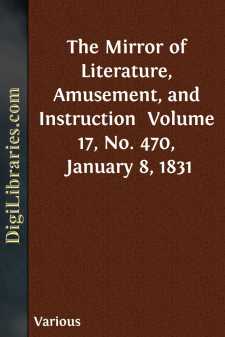Categories
- Antiques & Collectibles 13
- Architecture 36
- Art 48
- Bibles 22
- Biography & Autobiography 813
- Body, Mind & Spirit 142
- Business & Economics 28
- Children's Books 17
- Children's Fiction 14
- Computers 4
- Cooking 94
- Crafts & Hobbies 4
- Drama 346
- Education 46
- Family & Relationships 57
- Fiction 11829
- Games 19
- Gardening 17
- Health & Fitness 34
- History 1377
- House & Home 1
- Humor 147
- Juvenile Fiction 1873
- Juvenile Nonfiction 202
- Language Arts & Disciplines 88
- Law 16
- Literary Collections 686
- Literary Criticism 179
- Mathematics 13
- Medical 41
- Music 40
- Nature 179
- Non-Classifiable 1768
- Performing Arts 7
- Periodicals 1453
- Philosophy 64
- Photography 2
- Poetry 896
- Political Science 203
- Psychology 42
- Reference 154
- Religion 513
- Science 126
- Self-Help 84
- Social Science 81
- Sports & Recreation 34
- Study Aids 3
- Technology & Engineering 59
- Transportation 23
- Travel 463
- True Crime 29
The Mirror of Literature, Amusement, and Instruction Volume 17, No. 470, January 8, 1831
by: Various
Categories:
Description:
Excerpt
Few places in Britain can boast of higher antiquity than the city of Chichester. Its origin is supposed to date back beyond the invasion of Britain by the Romans. It was destroyed towards the close of the fifth century, by Ella, but rebuilt by his son, Cissa, the second king of the South Saxons, who named it after himself, and made it the royal residence and capital of his dominions.
Chichester, as may be expected, is a fertile field for antiquarian research. Its cathedral, churches, and ecclesiastical buildings abound with fine architecture; and its Cross is entitled to special mention. It is thus minutely described in the Beauties of England and Wales:
The Cross stands in the centre of the city, at the intersection of the four principal streets. According to the inscription upon it, this Cross was built by Edward Story, who was translated to this see from that of Carlisle, in 1475. It was repaired during the reign of Charles II., and at the expense of the Duke of Richmond, in 1746; though we are told that Bishop Story left an estate at Amberley, worth full 25l. per annum, to keep it in constant repair; but a few years afterwards the mayor and corporation sold it, in order to purchase another nearer home. The date of the erection of this structure is not mentioned in the inscription; but, from the style and ornaments, it must be referred to the time of Edward IV. This Cross is universally acknowledged to be one of the most elegant buildings of the kind existing in England. Its form is octangular, having a strong butment at each angle, surmounted with pinnacles. On each of its faces is an entrance through a pointed arch, ornamented with crockets and a finial. Above this, on four of its sides, is a tablet, to commemorate its reparation in the reign of Charles II. Above each tablet is a dial, exhibiting the hour to each of the three principal streets; the fourth being excluded from this advantage by standing at an angle. In the centre is a large circular column, the basement of which forms a seat: into this column is inserted a number of groinings, which, spreading from the centre, form the roof beautifully moulded. The central column appears to continue through the roof, and is supported without by eight flying buttresses, which rest on the several corners of the building. Till a few years since this Cross was used as a market-place; but the increased population of the city requiring a more extensive area for that purpose, a large and convenient market-house was, about the year 1807, erected in the North-street; on the completion of which, it was proposed to take down this Cross, then considered as a nuisance. Fortunately, however, the city was exempted from the reproach of such a proceeding by the public spirit of some of the members of the corporation, who purchased several houses on the north side of the Cross, in order to widen that part of the street, by their demolition.
The Topographer
COUNTY COLLECTIONS.
(For the Mirror.)Kent.
He that will not live long,
Let him dwell at Murston, Tenham, or Tong.
Queen Elizabeth's Gun at Dover.
"O'er hill and dale I throw my ball,
Breaker my name of mound and wall."
Deal famed much vaunts of new turrets high,
A place well known by Cæsar's victory.
Leland.
Dover, Sandwich, and Winchelsea,
Rumney and Rye the Five Ports be.
Hampshire—Sir Bevis of Southampton.
Bevis conquered Ascupart
And after slew the Boar,
And then he crossed beyond the seas
To combat with the Moor....












